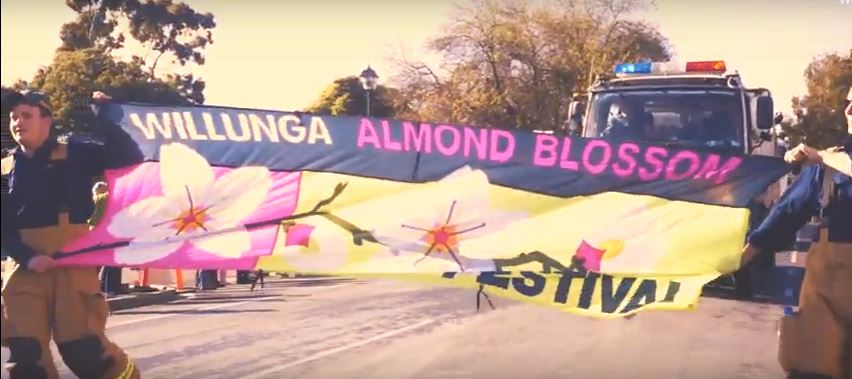27 Jul 2019 – 28 Jul 2019

Blossom Time
Almond trees are the first to flower in consideration with the other trees of the soft fruit varieties but the last to mature and be harvested. Blossoms started toappear in the coldest months late July & August.
Harvest Time
During the warmer months of February and March is harvest time or commonly known as’ knocking time’. Until recent years the method used was to knock the base of the boughs with a rubber waddy and the almonds would fall through onto a hessian sheet spread on the ground. The odd remaining almond on the tree was knocked off by using a long wooded pole. After completion the hessian was pulled into a long trailer called an almond boat or shovelled into bags. Now modernised ‘knocking’ is done with a hydralic tree shaker which clamps to the tree base and vibrates. Almobile sweeper the froems rows of almonds on the ground for collection.
Almond Cracking
Mr. G Max Herriot of Willunga invented and patented an almond cracking machine in 1942. His cracking machine was made locally and sold to almond orchardists world wide. The cracker consists of revolving discs with stuyds which the almonds pass through in turn cracking the shell.
History of Willunga Almond Blossom Festival
The festival has been the Willunga Recreation Park’s major fundraising event since 1969, when a local committee decided to raise money to build the Festival Hall. Today, proceeds from the festival continue to fund the maintenance and the continual upgrading of our park facilities. This week long event continues to be influenced, managed and powered by the generous donations of time, knowledge and dedication of volunteers within the Willunga community.
Willunga Recreation Park is owned and managed by the Willunga community
History of Willunga Recreation Park
The Willunga Recreation Park is “home” for many sporting clubs, markets, service and social organisations. These include the Willunga Football, Netball, Tennis, Cricket, Basketball and Table Tennis sporting clubs, the Willunga Quarry, Green Light and Artisan markets, Willunga Girl Guides, Meals on Wheels, Willunga RSL and CWA, Cinemallunga and 2nd Friday Film Club. Part of the land is leased to Willunga CFS and the park is designated as an emergency centre when the need arises, as was recently the case with the fires in the Willunga Hills. It also provides sporting and Festival Hall facilities for the Willunga Primary School.
The idea for such a park in Willunga was conceived in 1855 when the first Willunga Show was held on the land later earmarked for the Recreation Park. In 1875 a meeting of residents determined that a public park be provided for the use of local residents and, in January 1876, eight (8) acres of land was purchased for the sum of 96 pounds ($192). This land eventually became known as Willunga Recreation Park.
In 1876 the oval was established and the Show Hall was built for 360 pounds ($720), followed by the oval pavilion in 1903. The Almond Blossom Festival began in 1969, with the aim of raising funds to build the Festival Hall , which opened in 1979
Willunga Recreation Park has maintained its status as a multi-purpose park for the use of the residents of Willunga. Its management is the responsibility of the Willunga Recreation Park Incorporated (WRPI) volunteer committee on behalf of the community.
